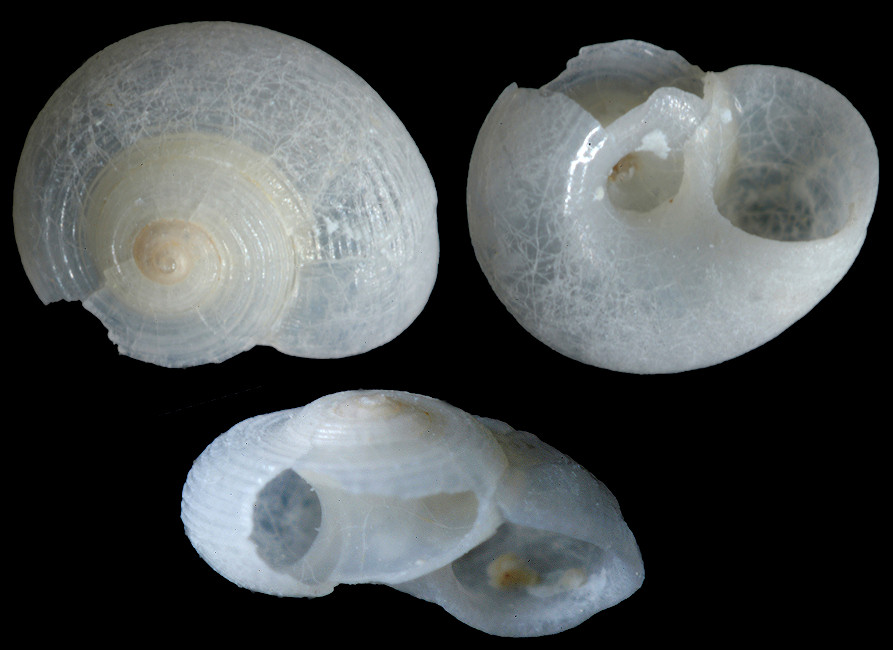| Circulus orbignyi (P. Fischer, 1857) |
 |
 |
|
From beach drift, Calabash Bay, St. Elizabeth Parish, Jamaica (top specimen 2.5 mm. and bottom specimen 2.3 mm.). Digital images by David Kirsh. |
|
Evolutionary origin |
|
by Harry G. Lee |
|
It seems that genuine Circulus orbignyi, and anything that might
be taken to be its antecedent, has not been found in the accessible,
well-studied, prolific Florida Neogene deposits. On the other hand, the nominal taxon Adeorbis orbignyi P. Fischer, 1857 has been applied to many New World fossils, including material from the "Miocene" of Santo Domingo; Chipola Formation of Calhoun Co., FL; "Miocene" of St. Mary's, MD; Natural Well, Duplin, Co., NC; "Newer Miocene" of the Cape Fear River; and [collected by C.W. Johnson] the Waccamaw beds of Tilly's Lake, SC (Dall, 1892: 344 <http://www.biodiversitylibrary.org/item/98240#page/354/mode/1up>), but these all appear to be based upon misidentifications. Some, particularly the MD to NC records, may have been Circulus costulatus (H.C. Lea, 1843). This species, considered restricted to the Pliocene, was first figured by Campbell (1993: pl. 26, fig. 256) and was considered ancestral to the "Pleistocene-and Recent" C. liratus (A.E. Verrill, 1882) by Campbell (1993: 59). The latter species, however, is very close to or identical with the Tilly's Lake specimen cited by Dall (loc. cit.). This was demonstrated by Gardner (1948: 189; pl. fig. 33), who, although she also mistook it for C. orbignyi, drew the description and figure from C.W. Johnson's USNM specimen! Thus it is also Pliocene, possibly coeval with C. costulatus, which is actually closer to C. orbignyi in possessing finer spiral sculpture than C. liratus. Unlike the condition in latter two, this sculpture carries onto the base. Perhaps C. costulatus, while possessing a wider umbilicus, is ancestral to C. orbignyi. Although far from impossible, this scenario is a bit unusual since C. orbignyi is Caribbean in distribution, nowadays extending northward on continental shores no further than Broward Co., FL (Rubio et al., 2011: 8, based on material in the Lee Collection). Campbell, L.D., 1993. Pliocene mollusks from the Yorktown and Chowan River Formations in Virginia. Virginia Division of Mineral Resources. Publication 127: 1-259. Gardner, J., 1948. Mollusca from the Miocene and Lower Pliocene of Virginia and North Carolina. United States Geological Survey Professional Paper 199-B. [ii] + 179-310+ pls. 24-38. <http://pubs.usgs.gov/pp/0199b/report.pdf> Dall, W.H., 1892. Contributions to the Tertiary fauna of Florida with especial reference to the Miocene silex-beds of Tampa and the Pliocene beds of the Caloosahatchie River. Part 2. Streptodont and other gastropods, concluded. Transactions of the Wagner Free Institute 3(2): 201-473 + map + pls. 13-22. December. <http://www.biodiversitylibrary.org/item/98240#page/205/mode/1up> Rubio, F., R. Fernández-Garcés, and E. Rolán [H.G. Lee ed.], 2011. The family Tornidae (Gastropoda, Rissooidea) in the Caribbean and neighboring areas. Iberus 29(2): vii + 1-230. December. |